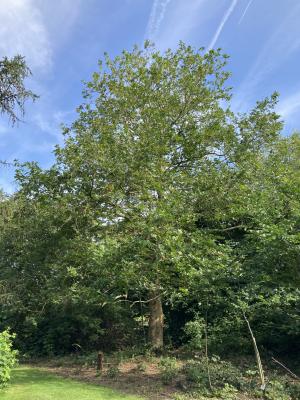Our Tree Collection
Unlike other trees, the plane sheds it's ageing bark regularly in large flakes, leaving behind creamy patches. This prevents the tree becoming stifled under sulphurous grime, and so enables it to thrive even in the polluted atmosphere of big towns and cities.
Though the leaves of the plane are shaped like those of the maple, they are up to 6 inches (15cms) across or more, and are set alternately along the stem and not in opposite pairs as in maples.
The large bright green leaves have spiky teeth. The male flowers are yellow and set farher back on the shoot, whereas the reddish female flowers are to be found at the tip of the shoot.The London plane is actually a hybrid of two other plane species; the American plane and the Oriental plane.
The brilliant green of a beech wood, just as it comes into full leaf, is a memorable sight. Inside such a wood all is shady even on the sunniest of days, because of the dense leaf canopy. Little else in the way of plant life will manage to grow at ground level. Older trees have a massive many branched dome and present a spectacular display in the autumn when the leaves turn first orange and then rich red-brown.
In autumn the familiar triangular beech nutlets contain pairs of nuts which are highly favoured by squirrels. Beech leaves are a shiny green with a wavy margin and distinctive veins. Beech is widespread throughout the British Isles.
This tall, handsome tree provides on of the most valuable of timbers, the raw materialfor a variety of products from oars and axe handles to farm carts and furniture. The leaves of the ash tree are particularly distinctive, made up of nine to thirteen pale-green leaflets.
The branches are smooth, grey or ash-coloured, with conspicuous hard black velvety buds. These black buds come in opposite pairs on a grey coloured twig.
Only the female holly tree bears the bright red berries which are so much a part of our traditional Christmas decorations.
As one of Britain's few native evergreen trees, the holly's leaves and berries were almost certainly used as a winter decoration in pre-Christian times. Being thick, with a waxy surface, the leaves resist water loss and last up to four years on the tree.
The sharp spines found on the tree's lower leaves are designed to protect them from the attentions of browsing animals. The leaves growing higher up are spineless. The bark is green when young and becomes smooth and grey later.
The holly flowers appear in May. The leaves are alternate, dark and glossy on top, paler underneath. Cultivated varieties of holly have different leaf colours and shapes.
The apple is a deciduous tree, generally standing 6 to 15 ft tall in cultivation and up to 30 ft in the wild. When cultivated, the size, shape and branch density are determined by rootstock selection and trimming method. The leaves are alternately arranged dark green-colored simple ovals with serrated margins and slightly downy undersides.
Blossoms are produced in spring simultaneously with the budding of the leaves and are produced on spurs and some long shoots. The 1 to 1.5 in flowers are white with a pink tinge that gradually fades, five petaled, with an inflorescence consisting of a cyme with 4-6 flowers. The central flower of the inflorescence is called the "king bloom"; it opens first and can develop a larger fruit.
The fruit is a pome that matures in late summer or autumn, and cultivars exist in a wide range of sizes. The skin of ripe apples is generally red, yellow, green, pink, or russetted. The skin may also be wholly or partly russeted i.e. rough and brown. The skin is covered in a protective layer of epicuticular wax. The exocarp (flesh) is generally pale yellowish-white, though pink, yellow or green exocarps also occur.
Larix decidua, the European larch, is a species of larch native to the mountains of central Europe, in the Alps and Carpathian Mountains as well as the Pyrenees, with disjunct lowland populations in northern Poland and southern Lithuania. It is widely naturalized in Scandinavia. Its life span has been confirmed to be close to 1000 years, but is more often around 200 years.
Larix decidua is a medium-size to large deciduous coniferous tree reaching 25-45 m tall, with a trunk up to 1 m diameter. The crown is conic when young, becoming broad with age; the main branches are level to upswept, with the side branches often pendulous. The shoots are dimorphic, with growth divided into long shoots (typically 10-50 cm long) and bearing several buds, and short shoots only 1-2 mm long with only a single bud. The leaves are needle-like, light green, 2-4 cm long which turn bright yellow before they fall in the autumn, leaving the pale yellow-buff shoots bare until the next spring.
The cones are erect, ovoid-conic, 2-6 cm long, with 10-90 erect or slightly incurved (not reflexed) seed scales; they are green variably flushed red when immature, turning brown and opening to release the seeds when mature, 4-6 months after pollination. The old cones commonly remain on the tree for many years, turning dull grey-black.
It is very cold tolerant, able to survive winter temperatures down to at least -50C, and is among the tree line trees in the Alps, reaching 2400 m altitude, though most abundant from 1000-2000 m. It only grows on well-drained soils, avoiding waterlogged ground and is not shade tolerant.





